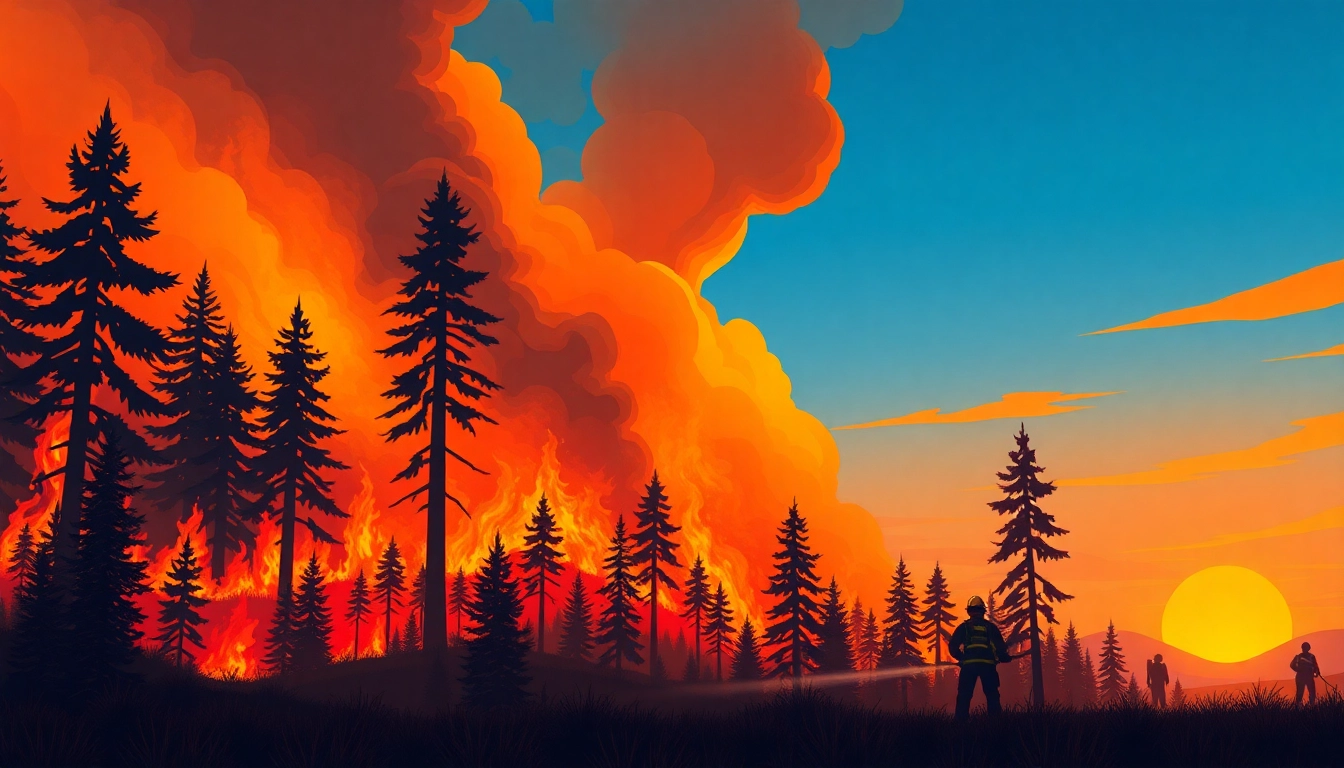Introduction to Wildfire Events
Wildfire events have become increasingly significant in today’s world, garnering attention due to their destructive potential and the complex interplay of environmental factors that contribute to their spread. These natural phenomena result from various causes, including human activity and climatic conditions, impacting ecosystems and communities alike. Understanding wildfire events is crucial for developing effective management strategies and community preparedness plans. In exploring this topic, we will delve into the definitions, importance, and causes of wildfire events while also considering their types, impacts on communities, management strategies, and future trends. To begin, let’s clarify what we mean when we refer to wildfire events.
What Are Wildfire Events?
Wildfire events are uncontrolled fires that spread rapidly through vegetation, often fueled by dry conditions, winds, and other environmental factors. They can occur in various landscapes, including forested areas, grasslands, and even urban environments. While they are a natural part of many ecosystems, wildfires can become catastrophic when they threaten human lives, property, and infrastructure. The intensity and frequency of wildfires have increased globally, driven by factors such as climate change, land management practices, and urban development.
The Importance of Wildfire Events
Understanding wildfire events is essential not only for managing and mitigating them but also for recognizing their role in the environment. Wildfires can help rejuvenate certain ecosystems, clear out underbrush, and provide necessary nutrients for soil replenishment. However, when they occur at an intensity or frequency that exceeds natural adaptive capacities, they can lead to devastating consequences. This duality underscores the need for balanced approaches to wildfire management, which cater to ecological needs while ensuring public safety.
Common Causes of Wildfire Events
Wildfires can originate from natural and human-induced causes. The primary natural causes include:
- Lightning Strikes: One of the most common natural igniters of wildfires, lightning can set off fires in remote areas where interventions are minimal.
- Drought Conditions: Extended periods without rain create dry vegetation that is highly flammable, setting the stage for wildfires.
On the human side, commonly observed causes include:
- Unattended Campfires: Campers leaving fires burning can lead to significant fire outbreaks.
- Equipment Use and Malfunction: Sparks from machinery or vehicle accidents can ignite surrounding vegetation.
- Arson: Intentional acts of setting fires pose one of the gravest risks to surrounding communities.
Types of Wildfire Events
Surface Wildfires
Surface wildfires are the most common type. They burn along the ground and primarily affect grasses, shrubs, and other low-lying vegetation. These fires tend to spread slowly, making them more manageable. Sometimes they can help rejuvenate the ecosystem by clearing dead plant material and encouraging new growth.
Crown Wildfires
Crown wildfires are more severe, occurring when the fire spreads through the canopy of trees. These fires are influenced heavily by weather conditions and can travel rapidly, leading to extensive destruction. Crown fires often pose a significant threat to wildlife and human communities, as they can create firestorms that are difficult to control.
Ground Fires
Ground fires burn beneath the surface of the soil, primarily affecting peat and organic material. These fires can smolder for long periods, potentially re-emerging in more favorable conditions. Ground fires are particularly concerning in areas with rich organic soils, as they can lead to delayed destruction of vegetation and severe ecosystem impacts.
Impact of Wildfire Events on Communities
Environmental Effects
The environmental impact of wildfire events extends well beyond the immediate area of the fire. While wildfires can play a role in the natural cycle of certain ecosystems, the overfrequency of such events can lead to:
- Loss of Biodiversity: Many species depend on specific habitats, which can be destroyed by fire.
- Soil Degradation: The loss of vegetation leads to soil erosion and degradation, affecting land productivity.
- Air Quality Issues: Smoke from wildfires can contribute to air pollution, affecting human and animal health.
Economic Consequences
Wildfire events can lead to significant economic costs for communities. The direct costs include expenses related to firefighting efforts, damage to property and infrastructure, and health care costs for individuals affected by smoke inhalation or fire-related injuries. Additionally, there can be longer-term economic impacts such as:
- Loss of Tourism: Areas affected by wildfires may see a decline in tourism, impacting local businesses.
- Decreased Property Values: Homes and properties within high-risk fire zones may experience a decrease in market value.
Health Risks from Wildfire Events
Health risks associated with wildfire events are multifaceted. They include immediate physical dangers such as burns and smoke inhalation. However, longer-term health consequences may arise, including respiratory issues and mental health concerns due to the trauma of experiencing a wildfire. Vulnerable populations, such as the elderly or those with pre-existing health conditions, face heightened risks during wildfire events.
Wildfire Management Strategies
Preventative Measures
Effective wildfire management begins with prevention. Key strategies include:
- Defensible Space: Creating buffer zones around properties by removing flammable vegetation can help protect homes.
- Community Training Programs: Educating communities on fire safety can significantly reduce human-caused ignitions.
- Fuel Management: Regularly thinning forests and conducting controlled burns can mitigate the intensity of wildfires.
Suppression Tactics
When wildfires occur, firefighting agencies employ a variety of suppression tactics, including:
- Aerial Attacks: Utilizing helicopters and fixed-wing aircraft to drop water or fire retardant can be vital in initial suppression efforts.
- Ground Crews: Firefighters on the ground create fire lines and use hand tools to cut down vegetation and create barriers.
- Fire Engine Deployment: Fire engines equipped with water and pumps are dispatched to protect structures as needed.
Community Preparedness for Wildfire Events
Preparing communities for potential wildfire events involves proactive planning and response strategies. The key elements of community preparedness include:
- Evacuation Plans: Establishing clear evacuation routes and plans can dramatically reduce casualties during a wildfire.
- Emergency Communication Systems: Keeping the public informed about fire conditions and safety measures is crucial.
- Community Involvement: Engaging community members in planning and preparedness fosters a culture of resilience.
The Future of Wildfire Events
Adapting to Climate Change
As climate change alters weather patterns and increases the frequency of extreme weather events, wildfire management strategies must adapt. This includes:
- Revising Fire Modeling: Utilizing updated climate models to predict areas at risk and tailor management strategies effectively.
- Incorporating Indigenous Knowledge: Drawing on traditional land management practices that enhance resilience to wildfires.
- Policy Development: Advocating for policies that support fire management funding and sustainable land use.
Innovations in Fire Management
With the advancement of technology, fire management strategies are evolving. Innovations include:
- Remote Sensing: Using satellite imagery and drone technology to monitor and predict fire behavior more accurately.
- Predictive Modeling Tools: Software that analyzes weather, fuel type, and terrain to forecast fire outbreaks.
- Community Apps: Implementing mobile apps that provide real-time updates about fire risks and safety tips.
Wildfire Events: Trends and Predictions
Looking ahead, trends indicate that wildfire events will likely become more frequent and severe due to ongoing climate change. Experts predict that areas previously considered low risk may experience increased fire activity, necessitating enhanced focus on:
- Research and Data Analysis: Continued research into fire behavior and environmental impacts will inform better management strategies.
- Collaboration Among Agencies: Effective wildfire management requires cooperation among federal, state, and local agencies.
- Public Engagement: Raising awareness of wildfire risks and prevention strategies will empower communities to take proactive measures.



